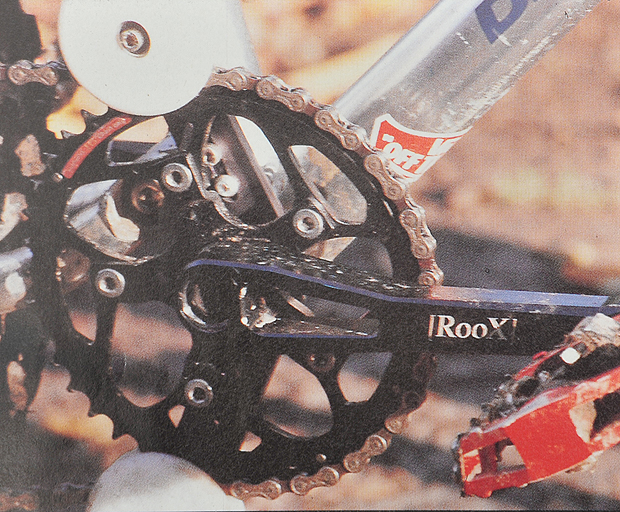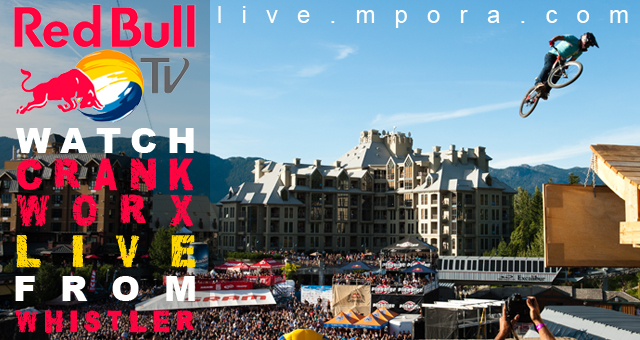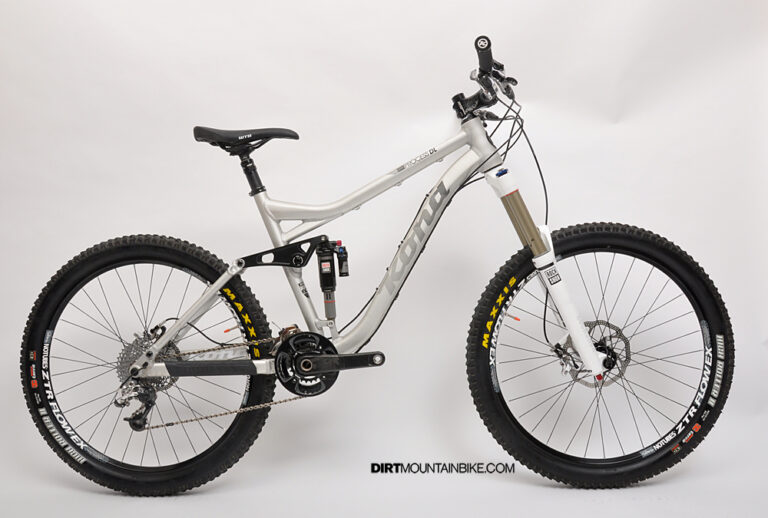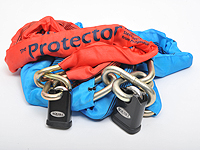We’re continuing our blast from the past series and are sticking with issue #1 of Dirt (Jan/Feb 1997), but this time around it’s the turn of those new fangled chain device things…

It seems strange to think about a chain device being a new product in the world of downhill, but in the early days of the sport apart from a bit more suspension there was very little that separated a DH from an XC one, most were even fitted with a triple chainset. Home grown chain devices were common place on the race scene as racers seemed to grasp the problem before any companies did. When manufacturers did finally cotton on it wasn’t much better for many racers either as many companies appeared to cash in on the fact that it was a product that you really needed. I mean £189 for the then benchmark MRP equates to about £290 in today’s money! All that for a couple of rollers and some machined out sheets of aluminium.
Of course there was also no such thing as an ISCG mount back then, everything had to be either mounted off your bottom bracket shell or clamped around your seat tube. Basically if you think that fitting a chain device today is tricky you should have tried fitting one back then. Nothing was ever simple. My particular favourite at the time was the Mr Dirt one. Yes it was far from pretty and you had to cut the lower bit off to prevent it from continuously dragging in the dirt, but it was sensibly priced, could be relatively easily modified to fit pretty much any bike, was very quiet compared to other designs at the time, and crucially it was ultra reliable in terms of preventing chain loss because of the way it fully encased the chain and guided it on and off the ring (the outer part of the lower guide is for some reason missing in the photo below). On the negative side it did love to collect mud which increased chain drag, and it had no form of bash protection. Oh, and what was it back then that made us all want to run insanely big chain rings?
Anyway, here’s the original article, and feel free to share any fond/dreaded memories of chain devices from yesteryear…
DOWNHILL CHAIN DEVICES
Mechanicals suck! Rim, frame, fork, shock or drive train failure – they all suck! Well, we’ve got one of them sussed: there’s nothing worse than putting in all that training (ahem), loading up on carbo, spending hard earned cash on entry fees and travel expenses, hyping yourself to the limit, only to drop your chain on the run that felt like the best you’d ever had.
More and more racers are finding out the importance of running a chain device. They cost big bucks, but weigh it up and I’d bet you’d rather get down with a solid time. Some devices work on both the top and bottom of the chain ring, others only run on the top; ‘top only’ is OK if you remember not to back pedal during your run. But that’s a bit difficult with a load of corners on the course, so if you’re going to get a ‘top only’ device, take a couple of links out of the chain to reduce ‘slap’ or run a chainstay mounted device as well – if you have a raised beam, you don’t have much choice. So we’ve gone out and tested some of the best devices on the market: you see the product – you make the choice.
BULLET BROS T2 DOWNHILL ROLLER SYSTEM
The T2 has been on the market for some time now, before we say any more, using rollers rather than ‘encase’ the chain can cause problems if installed badly – correct chain alignment is essential – so read the instructions!
The T2 has adjustable arms which position two Teflon rollers at 11 and 7 o’clock on the chainring (48-60 tooth). The chain lies in the roller which rotates, effectively locking the chain in. Features include self lube bearings and an internal tooth washer to prevent the arms from slippage. Fitting and aligning the T2 is fiddly (especially the top roller), but once it’s done, it stays done. Instructions are very comprehensive and should be referred to! You’ll need a flanged BB.
If the arms rotate, use a steel BB (they recommend this anyway) so you can tighten it right up. This system works really well, it’s a bit on the noisy side, but who cares, you’re not going to get disqualified for noise pollution! Don’t go riding it up steps, ‘cos the rollers aren’t exactly concrete proof! Hotlines do have spares back up though. Other than that, keep a regular eye on the bolts ‘n things for tightness and you’ve got a fail-safe system – but read the instructions!
Price: £79.95
Hotlines
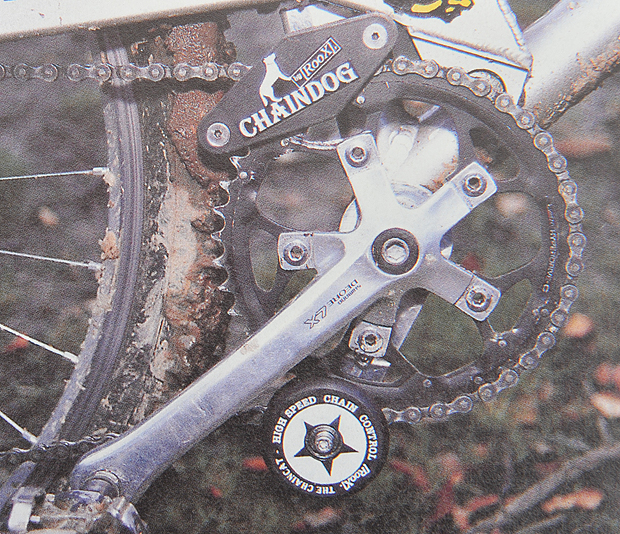
ROOX CHAINCAT & CHAINDOG
The Chaincat is basically the bottom half of a T2! But not at half the price! Anyway, the Chaincat has been ‘World Cup’ tested and is now available to us lot. Like the T2, the Cat features an adjustable arm (takes ring sizes 36 to 54t) on the end of which is a Teflon roller secured to a steel axle via a sealed bearing. Alignment is easy because it’s the bottom roller. It’s fixed to the BB inner flange and tightened down like the T2.
The Chaindog is a now familiar design for top devices. According to ROOX, it’s used by more European and national champions than any other device!? The Dog has a dual bolt clamp to fix around your seat tube, the outer plate of the housing is removable for chain loading, two Teflon rollers at each end of the plate keep the chain ‘locked’ onto the ring. Steel sliding pins are fixed to the back plate for spacing. Fitted correctly this combo works perfectly and won’t let you down – nice finish!
Price: £55.00 (Cat), £59.99 (Dog)
Ison Distribution

AC (ADVENTURE COMPONENTS) PRO CHAIN GUIDE SYSTEM
The boys at AC have made loads of mods to the original device. The latest being the introduction of a new bottom guide. Basically they’ve made it fail safe. And for that you’ve gotta pay! The AC device is a two piece affair, the housing, manufactured in (anodised) aluminium, clamps to the seat tube via four bolts.
The plate removes for chain loading, and internally, there are Teflon runners to keep the noise down (and to keep the chain in!). The 9new) lower system has a double sided bottom bracket shell mount for rigidity, with a guide and jockey wheel fixed at the end of the spring loaded arm to keep the chain well secure. So the chain can slap all it likes but it ain’t going anywhere – this thing means the business, and so it bloody should at that price.
Price: £199.00
Hotlines
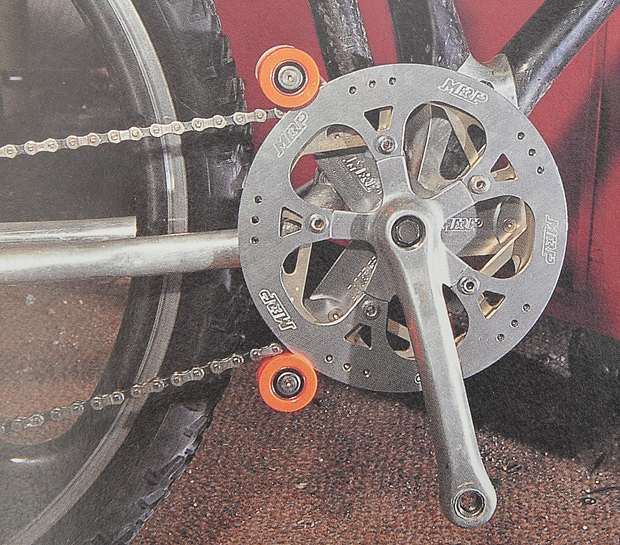
MRP DH-1 ULTRA
The Ultra device is currently one of the most popular devices on the World Cup race scene. Loads of racers use home grown double disc retention systems. That’s what this is, but it’s CNC machined and also has a T2 type roller system to keep the chain well and truly ON!
The double sided disc is well finished and keeps the chain nicely in the trough. The tough rubber rollers are fixed via two big bearings to a ‘delta’ shaped arm that’s fixed to the inner plate and the BB shell via the usual flanged cup with two allen pins keep it fixed.
The outer plate fixes to the outer position of the spider with the chain ring located in the middle. I know it sounds confusing, but once you’ve sussed it, it’s a cinch! The MRP takes 46 to 60 tooth rings (and there’s a sticker included).
Price: £189.00
Hotlines

MR DIRT BOOMERANG CHAINGUIDE
I hope you did Meccano when you were a kid, ‘cos this thing will probably have you scratching your head for a while. Open the box and you’ve got two brackets (for large and small ring set up), the guides, which are model kit style snap off moulded hard rubber, the retaining bracket and a re-sealable bag with all the fixings, which includes screws, nuts ‘n bolts and shed loads of washers.
Don’t panic! Relax and read the instructions over a cup of tea – it’s not that bad. For a start, you only use one of the brackets, the washers are spacers, and the whole thing goes together easily. The Boomerang is a BB flange mounted device with the guide located at the bottom. If the laws of physics are applicable, it’s fail safe. The chain is locked between the plates, which unscrew for easy inspection, cleaning and general maintenance. An additional bracket is included for securing the top guide against lateral movement. Noise is almost unnoticed whilst friction between the guides is zero if you get the spacing right – all in, a tasty bit of kit.
Price: £59.99
Mojo
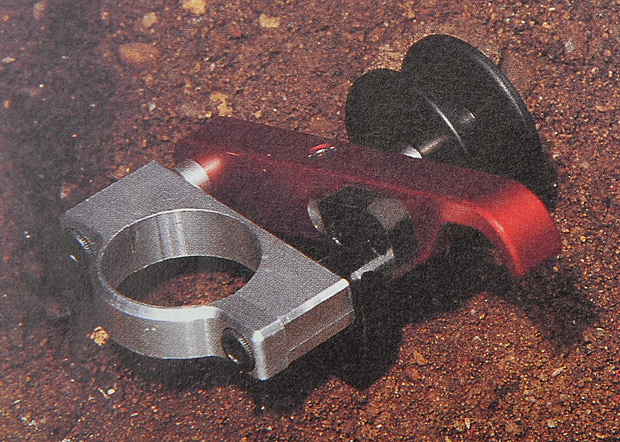
CHAIN ASSASSIN
The Chain Assassin is designed by one of the many engineering companies jumping into downhill. It’s a top device with a dual bolt clamp assembly which is pretty standard, but that’s where the ‘standard’ bit ends. The Assassin uses a roller which spins on an ali axle with a small amount of float to eliminate friction.
The device has a ‘quick release’ arm which, once it is secured to the seat tube, can be pulled upward for access to the chain ring. If you run the Assassin, to be sure, run a chainstay mounted device like a DCD to keep the chain taut on the bottom of the ring. It’s light, and it works.
Price: £TBA
Zoobits
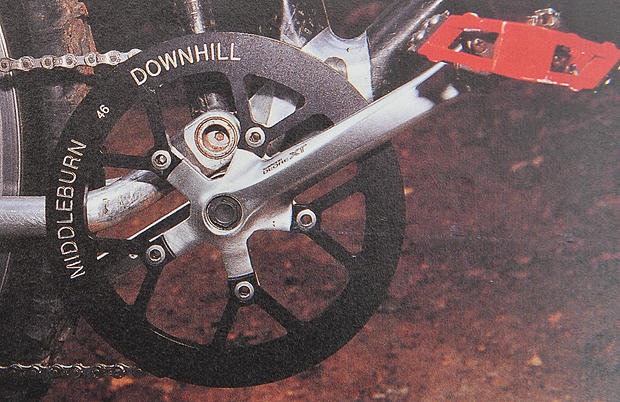
MIDDLEBURN DOWNHILL CHAINRING
Middleburn’s Downhill chainring is available in almost every anodised colour of the rainbow. The all-in-one device is a CNC machined outer ring with a toothed chainring. Available in all ring sizes up to 52 and BOT, hyper, and standard drive formats, the DH ring has a high sided outer section which keeps the chain out of trouble, and, at the same time, protects the teeth from rock or debris.
Bolted straight onto the spider, fixing is easy. But for peace of mind, chop up an old front mech, and lock the inner plate onto the chain to stop it from jumping off inboard. Overall, the DH ring is effective. Even with no top support, the chain stayed on, but that might not have been the run that counted…so get chopping.
Price: £79.99
Zoobits

